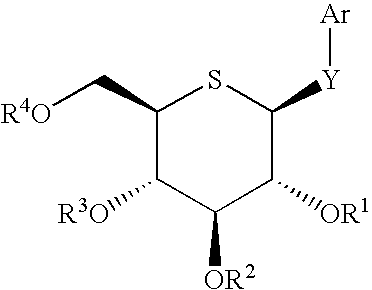Novel SGLT inhibitors
a technology of sglt inhibitors and inhibitors, which is applied in the field of new sglt inhibitors, can solve the problems of edema, heart failure, and significant hypoglycemia of anti-diabetic agents, and achieve the effects of reducing the risk of cardiovascular disease, reducing and improving the effect of sglt inhibitors
- Summary
- Abstract
- Description
- Claims
- Application Information
AI Technical Summary
Benefits of technology
Problems solved by technology
Method used
Image
Examples
example 1
3-(4-Ethylphenylmethyl)-1-(5-thio-β-D-glucopyranosyl)indole
[0224](1) Penta-O-acetyl-5-thio-D-glucopyranose (813 mg) was suspended in ethyl alcohol (20 ml), and thereto was added sodium methoxide (28% methanol solution, 2 drops). The mixture was stirred at room temperature for one hour under argon atmosphere to give a solution of 5-thio-D-glucopyranose. To the solution was added indoline (238 mg), and the resultant mixture was refluxed overnight. Thereto was added acetic acid (2 drops), and the mixture was again refluxed for 7 hours. After being cooled to room temperature, the solvent was evaporated under reduced pressure to give crude 1-(5-thio-β-D-glucopyranosyl)indoline, which was used in the subsequent step without further purification.
[0225](2) The above compound was dissolved in chloroform (20 ml), and thereto were added successively acetic anhydride (1.51 ml), pyridine (1.29 ml) and 4-(dimethylamino)pyridine (24 mg). After being stirred at room temperature for 2.5 days, the or...
example 2
4-Chloro-3-(4-ethylphenylmethyl)-1-(5-thio-β-D-glucopyranosyl)indole
[0231](1) Penta-O-acetyl-5-thio-D-glucopyranose (1323 mg) was suspended in ethyl alcohol (30 ml), and thereto was added sodium methoxide (28% methanol solution, 2 drops). The mixture was stirred at room temperature for one hour under argon atmosphere to give a solution of 5-thio-D-glucopyranose. To the solution were added 4-chloroindoline (500 mg) and ammonium chloride (174 mg), and the resultant mixture was refluxed for 22 hours. After being cooled to room temperature, the solvent was evaporated under reduced pressure to give crude 4-chloro-1-(5-thio-β-D-glucopyranosyl)indoline, which was used in the subsequent step without further purification.
[0232](2) The above compound was dissolved in chloroform (20 ml), and thereto were added successively acetic anhydride (2.45 ml), pyridine (2.10 ml) and 4-(dimethylamino)pyridine (40 mg). After being stirred at room temperature overnight, the organic solvent was evaporated u...
example 3
4-Chloro-3-(4-ethylphenylmethyl)-1-(4-fluoro-4-deoxy-β-D-glucopyranosyl)indole
[0235](1) A suspension of 4-chloroindoline (1.00 g) and D-galactose (1.94 g) in H2O (3.0 ml)-ethyl alcohol (20 ml) was refluxed for 29 hours under argon atmosphere. The solvent was evaporated under reduced pressure to give crude 4-chloro-1-(β-D-galactopyranosyl)indoline, which was used in the subsequent step without further purification.
[0236](2) The above compound was suspended in chloroform (20 ml), and thereto were added successively acetic anhydride (4.92 ml), pyridine (4.21 ml) and 4-(dimethylamino)pyridine (80 mg). After being stirred at room temperature for 1.5 hours, the organic solvent was evaporated under reduced pressure. The residue was dissolved in ethyl acetate (70 ml), and the mixture was successively washed with a 10% aqueous copper(II) sulfate solution and a saturated aqueous sodium hydrogen carbonate solution (20 ml). After being dried over magnesium sulfate, the insoluble materials were ...
PUM
| Property | Measurement | Unit |
|---|---|---|
| temperature | aaaaa | aaaaa |
| temperature | aaaaa | aaaaa |
| temperature | aaaaa | aaaaa |
Abstract
Description
Claims
Application Information
 Login to View More
Login to View More - R&D
- Intellectual Property
- Life Sciences
- Materials
- Tech Scout
- Unparalleled Data Quality
- Higher Quality Content
- 60% Fewer Hallucinations
Browse by: Latest US Patents, China's latest patents, Technical Efficacy Thesaurus, Application Domain, Technology Topic, Popular Technical Reports.
© 2025 PatSnap. All rights reserved.Legal|Privacy policy|Modern Slavery Act Transparency Statement|Sitemap|About US| Contact US: help@patsnap.com



